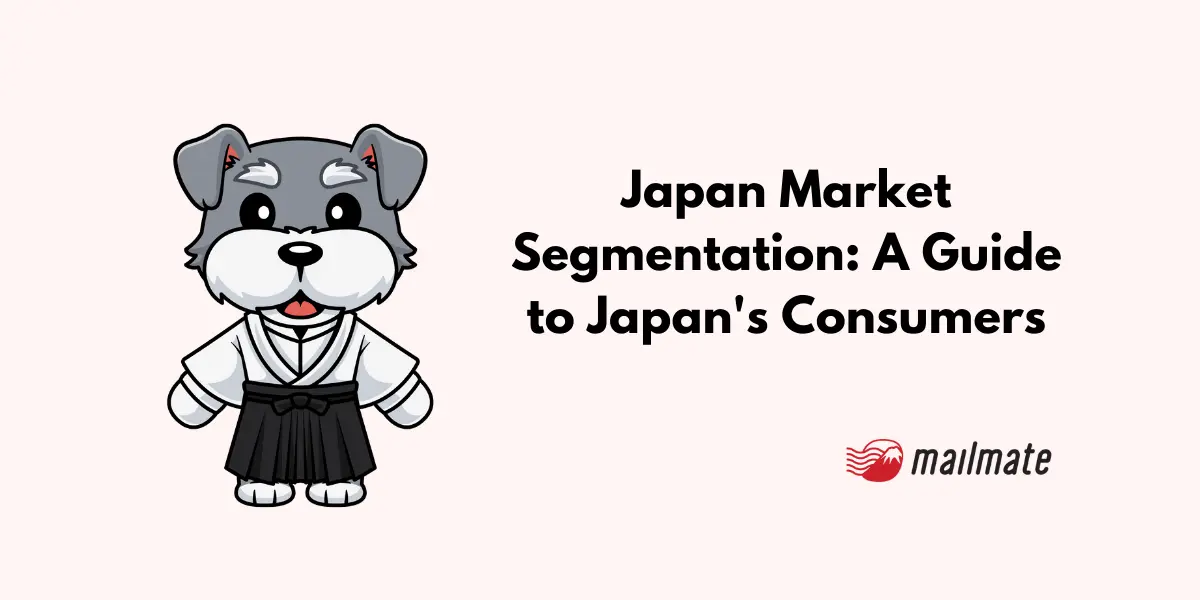Japan Market Segmentation: A Guide to Japan's Consumers

Who should you be selling to in Japan? What are their spending patterns and driving interests?
Knowing who you are trying to sell to is critical to creating an effective Japanese marketing campaign. So what should you know about market segmentation in Japan?
Globally, terms such as boomers, Gen Z, and Gen X give us a snapshot of generational market segments. However, in Japan, marketing consultants use different terms to refer to generational market segments.
In a study published by the Nomura Research Institute (NRI), titled "Perspectives on consumer behavior from a generational analysis, (trans. title)," NRI examines Japan's unique generational consumer profiles, their interests, and keys to each generation, based on a survey of 10,065 respondents ranging from 15 to 79 years old.
Here's our summary of NRI's generational analysis to get you started in finding your ideal customer.
Bubble-era generation (63- to 73-year-olds)
Japan's bubble-era generation was born between 1960 and 1970 and spent their formative years experiencing Japan at its economic height.
Buying brand items was a matter of prestige for this era, so being mindful of what others think is essential in marketing to the bubble-era generation. Other key takeaways about marketing to this generation include the following:
Enjoys consumerism.
Prefers to buy well-known brand items even if they are on the pricy side.
Willing to spend money on relationships and entertainment.
Company relationships are at the center of their social nexus. However, in the future, hobbies and new skills will be the keys to this demographic.
Primary information sources are Internet and TV commercials for gathering information about a product.
Second-wave/post-second-wave boomer (52- to 62-year-olds)
Japan's second-wave/post-second-wave boomer generation was born between 1971 and 1981, often called the "unlucky-generation" as they entered their twenties after the bubble burst in 1991 and deflation set in, influencing career choices and trajectories.
Respondents in this age category gave answers that revealed values geared toward personal freedom over salary. Key takeaways about marketing to this generation include the following:
Willing to spend a tremendous amount on their children's education to give them every advantage possible.
Far more individualistic than the older generations.
Prefers looser relations and connections with people and enjoys spending time alone.
Many in this generation segment are in double-income households and look to convenience as a key when making purchasing decisions.
Primary information source is the Internet when looking to purchase a product.
Enlightenment era (29- to 39-year-olds)
Japan's enlightenment-era generation (satori sedai) was born between 1983 and 1994 and spent their formative years in the aftermath of Japan's bubble economy collapse.
This generation correlates with the US's Gen-Z age bracket. Japan's satori generation grew up during economically stagnant times and have seen large companies go bankrupt, which has affected their attitudes toward work and consumption.
Avoids excessive consumerism in efforts to preserve financial stability.
Values their private lives over their work.
Values experiences over things.
Spends on average 3 hours on the Internet daily.
Finding ways to lower uncertainty over purchases is an important issue for this generation.
Digital natives (18- to 28-year-olds)
Japan's digital natives were born between 1995 and 2005. This generation grew up using the Internet and likely owned a smartphone by the time they started high school.
Like those of the enlightenment era, digital natives grew up in a more relaxed education environment and currently show the least interest in excessive consumption. Key takeaways about marketing to digital natives include the following:
Highest contentment rate compared with other generations.
Average Internet usage time per day is 4 hours.
Spends the most time on social channels, compared to other generations.
Online circles are a persuasive force in making personal decisions.
Twitter, Instagram, social media, and social media campaigns influence purchasing choices.
Non-generational market segments
Outside of the generational forces at play, marital and employment status and household makeup significantly affect consumer habits.
The following are other groups that hold increasing purchasing power in Japan:
The solo man
According to Hakuhodo Consulting, this segment is between 20 to 50 years old, independent/lives alone, and enjoys being self-sufficient. Common characteristics include valuing hobbies and a preference for a leisurely lifestyle over a high salary. Purchasing interests center on lifestyle enhancement and hobby enjoyment.
The power couple
As researched by the National Life Insurance, this segment's characteristics are where both partners work, and each makes over 7 million yen per year. Purchasing interests include time-saving goods and services and a willingness to outsource to reduce time costs.
The double income no kids (DINKS) couple
In recent years, the term "DINKs" (Double Income No Kids) has gained popularity in Japan, referring to married couples who work and do not have children. One of the benefits often cited for choosing the DINKs lifestyle is the financial freedom it provides.
According to reporting by DINKS magazine, a DINK household reports an annual income 2 million yen higher than the annual income of dual-income households, including those raising children.
The DINKs market segment in Japan is characterized by high financial stability and freedom, making it an attractive target for businesses. Understanding this group's lifestyle choices and financial habits can help create effective marketing strategies for the Japanese market.
The new adult generation
Profiled by Shin Otona Ken, this category is in their 40s to 60s who look at retirement as a second lease on life, a chance to get to the things they have been putting off. Interests include starting a new business, joining new clubs, etc.
The around 40s "ara for" unmarried woman
Towards the end of the 2000s, a term that gained popularity in Japan was "Arafo" (アラフォー), referring to women around their 40s. This term became a social phenomenon and was selected as one of the top buzzwords of 2008.
The "Arafo" generation emerged under the Equal Employment Opportunity Law enacted in 1986, allowing women to choose between work and marriage more freely. With the benefits of maternity leave and childcare leave systems, it became marginally easier for women to balance work and life after marriage and childbirth. Moreover, this generation, which enjoyed their youth during the peak of the economic bubble, is characterized by strong purchasing and consumption desires.
Given these circumstances, many "Arafo" women are unmarried career women with relatively high financial stability, seeking new ways of living that were not bound by traditional female roles. Companies that noticed this trend targeted these financially stable, unmarried women in their 40s, launching high-priced products such as cosmetics, spas, and apartments for single people, leading to the establishment of the "Arafo market" as a significant market segment.
Frequently asked questions
What are the different market segments in Japan?
In Japan, market segments are often categorized differently than in the United States. Some of the key generational market segments include the Bubble-era generation (51- to 61-year-olds), Second-wave/post-second-wave boomer (40- to 50-year-olds), Enlightenment era (27- to 38-year-olds), and Digital natives (16- to 26-year-olds). There are also non-generational market segments influenced by marital and employment status and household makeup.
What are the common characteristics used for market segmentation in Japan?
Market segmentation in Japan often starts with the most common characteristics like age, gender, place of residence, and other easily identifiable traits. However, more specific segmentation can be done based on lifestyle, income, and consumer behavior.
Who are the key consumer segments in Japan?
Some of the key consumer segments in Japan include Women, Millennials, and Seniors. These groups often have distinct purchasing behaviors and preferences, making them important targets for marketing strategies.
What is the importance of marketing in Japanese for local consumers and businesses?
Marketing in Japanese is essential to communicate effectively with local consumers and businesses. Understanding the language and culture can help businesses tailor their marketing strategies to resonate with Japanese consumers.
What is the significance of age in segmenting the Japanese market?
Age group segments are a significant factor in analyzing the Japanese population due to structured events and age-based cultural norms. Consequently, businesses often use age as a segmentation variable when targeting the Japanese market.
Final thoughts
Across the majority of market segments in Japan, Japanese are increasingly reluctant to part with their earnings.
Therefore, even a slight mismatch or misunderstanding of spending patterns and values will hold you back from finding your customers.
This article broadly summarizes Japan's more widely discussed market segments. Yet, the more specific you can get with market segmentation—such as looking at reports on monthly expenses of various income-earning brackets—the easier it will be to identify your ideal customers and position your product or service accordingly.
Spending too long figuring out your Japanese mail?
Virtual mail + translation services start at 3800 per month. 30-day money-back guarantee.

